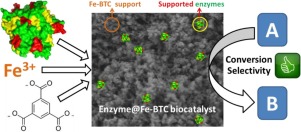Catalysis Today ( IF 5.2 ) Pub Date : 2017-10-26 , DOI: 10.1016/j.cattod.2017.10.022 Victoria Gascón , Mayra B. Jiménez , Rosa M. Blanco , Manuel Sanchez-Sanchez

|
Metal-organic frameworks (MOFs) have revolutionized the potential applications of nanoporous materials. One of the most recent and promising applications of these materials is their use as supports for enzyme immobilization. In this context, the in-situ (one-step) methodologies, which do not require the use of MOFs with pores larger than the enzyme to be immobilized, seem to be particularly encouraging. This work presents a systematic study of the semi-crystalline Fe-BTC MOF material (commercialized as Basolite F300) employed as support of the enzymes laccase and lipase through either in-situ or post-synthesis methodology. The presence of the enzyme in the resultant solid biocatalysts was proved by CHNS chemical analysis, thermogravimetric analysis, Bradford assays and by SDS-PAGE electrophoresis. The enzymatic activity of the resultant Fe-BTC-based biocatalysts was also tested. The in-situ approach is particularly relevant due to various reasons: (i) the enzyme immobilization is given in one step; (ii) it is rapid (10 min); (iii) it is very efficient in terms of encapsulation capacity (≥98% for laccase and ≥87% for lipase); (iv) the enzymes are fully retained and no leaching is observed after an initial release of only around 10% of the enzyme molecules weakly immobilized; and (v) the activity of the retained enzyme can be substantially maintained (97% with respect to the free enzyme in the case of lipase). Any of these parameters systematically improves these given by the post-synthesis (two-step) approach. Moreover, Fe-BTC widely surpasses the benefits given by other MOF-based supports either by in-situ or post-synthesis approaches.
中文翻译:

半结晶Fe-BTC MOF材料可有效固定酶
金属有机框架(MOF)彻底改变了纳米多孔材料的潜在应用。这些材料的最新和有希望的应用之一是它们用作酶固定化的载体。在这种情况下,不需要使用孔径大于待固定酶的MOF的原位(一步法)方法似乎特别令人鼓舞。这项工作提供了对半结晶Fe-BTC MOF材料(商品名为Basolite F300)的系统研究,该材料可通过原位或合成后方法支持漆酶和脂肪酶。通过CHNS化学分析,热重分析,Bradford分析和SDS-PAGE电泳证明了所得固体生物催化剂中酶的存在。还测试了所得的基于Fe-BTC的生物催化剂的酶活性。由于各种原因,原位方法尤其重要:(i)一步固定酶;(ii)快速(10分钟);(iii)在包封能力方面是非常有效的(漆酶≥98%,脂肪酶≥87%);(iv)酶被完全保留并且在最初释放的约10%弱固定化的酶分子最初释放后未观察到浸出;(v)可以基本上保持所保留的酶的活性(在脂肪酶的情况下,相对于游离酶为97%)。这些参数中的任何一个都可以系统地改进后合成(两步)方法所提供的参数。而且,无论是原位合成还是合成后合成,Fe-BTC都大大超过了其他基于MOF的支持物所带来的好处。











































 京公网安备 11010802027423号
京公网安备 11010802027423号